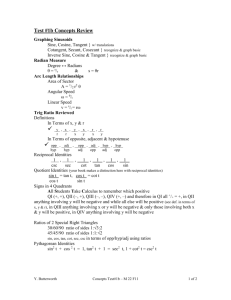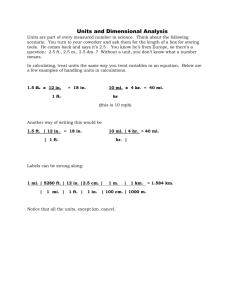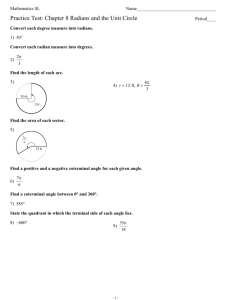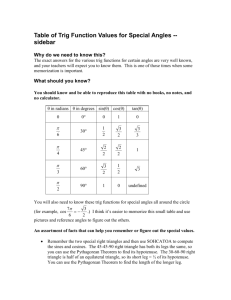Word format
advertisement
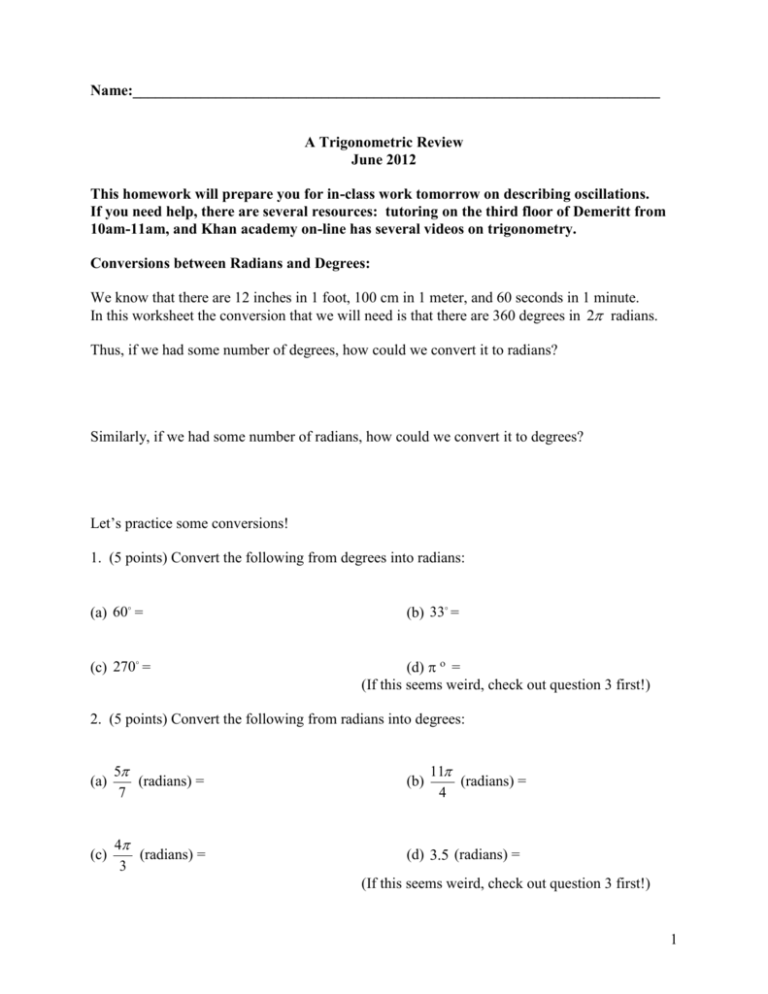
Name:______________________________________________________________________ A Trigonometric Review June 2012 This homework will prepare you for in-class work tomorrow on describing oscillations. If you need help, there are several resources: tutoring on the third floor of Demeritt from 10am-11am, and Khan academy on-line has several videos on trigonometry. Conversions between Radians and Degrees: We know that there are 12 inches in 1 foot, 100 cm in 1 meter, and 60 seconds in 1 minute. In this worksheet the conversion that we will need is that there are 360 degrees in 2 radians. Thus, if we had some number of degrees, how could we convert it to radians? Similarly, if we had some number of radians, how could we convert it to degrees? Let’s practice some conversions! 1. (5 points) Convert the following from degrees into radians: (a) 60 = (c) 270 = (b) 33 = (d) = (If this seems weird, check out question 3 first!) 2. (5 points) Convert the following from radians into degrees: (a) 5 (radians) = 7 (b) (c) 4 (radians) = 3 (d) 3.5 (radians) = 11 (radians) = 4 (If this seems weird, check out question 3 first!) 1 3. (3 points) Two students are having a disagreement: Sophie: There should always be a when you have radians, because really means radians. Nate: No, is not the same as radians. It’s just a number. The circumference of a circle is 2r, and that’s NOT an angle in radians, it’s a length. What do you think? You can agree with either, parts of both, or just one. Explain your reasoning. (After considering this conversation, you may want to change answers in the last question.) Right Triangle Trigonometry: Right Triangle Definitions of Trigonometric Functions Let be an acute angle of a right triangle. Then we define three trigonometric functions as follows: adj opp opp cos tan sin hyp adj hyp Where the abbreviations opp, hyp, and adj represent the lengths of the 3 sides of a right triangle: opp = length of the side opposite adj = length of the side adjacent to hyp = length of the hypotenuse hyp opp adj A common mnemonic for remembering these ratios is the word SOHCAHTOA (SOH stand for Sine=Opp/Hyp, etc) The Pythagorean Theorem will also prove very useful in these problems: hyp 2 opp 2 adj 2 2 4. (5 points) Given the following triangle, find the length of the unlabeled side and then find the values of the three trigonometric functions when they are evaluated at the angle shown in the figure. From here on out, do NOT use your calculator; express your answer exactly (that is, leave in square roots, fractions, , etc.). sin()= cos()= 5 12 tan()= 5 , find the exact values of the remaining two trigonometric functions 7 evaluated at . [Hint: Draw a diagram!] 5. (5 points) If cos cos 5/7 sin tan 6. (2 points) Sketch (making sure the angle sizes are at least relatively accurate) a 30-60-90 triangle. WITHOUT using your calculator, which is bigger sin 30o or cos 30o? How can you tell from your sketch? 3 The Unit Circle: Sine and cosine also define the x and y coordinate pairs on the unit circle (circle of radius 1) since we can form a right triangle around the angle as follows: y x, y 1 x Thus opp y y hyp 1 adj x cos x hyp 1 sin 7. (10 points) Three important angles in the unit circle are 30o (=/6 rads), 45o (=/4 rads), 60o (=/3 rads). Use the following triangles, definitions of trig functions, general knowledge of triangles, and Pythagorean theorem to find the sines and cosines of these angles WITHOUT using a calculator: cos(30o)= 1 sin(30o)= 1/2 cos(60o)= o 30 sin(60o)= cos(45o)= 1 sin(45o)= 45o 4 Using information on the previous page, the angles provided, and that fact that this is a unit circle, fill in the blanks below (each set of blanks are the x,y coordinates of the nearest large dot). y ____, ____ ____, ____ ____, ____ 60 90 45 ____, ____ 30 ____, ____ 180 ____, ____ x 270 ____, ____ 5 8. (5 points) Using the unit circle to guide your thinking, a. Explain why |cos | and |sin | are always less than or equal to one. b. For what range of angles (between 0 and 2) is sine positive? Negative? c. For what range of angles (between 0 and 2) is cosine positive? Negative? Note: When you sketch sine and cosine, the values at =0, /2, , 3/2 and 2 are easy to remember and can guide you in sketching the whole function. Use your graphing calculator to get a sense of the function in between these points. We will call these the “anchor points” for the function. Lastly, we need to define a few terms. Any function that repeats is called a periodic function; each repetition is called a cycle. Here is an example showing three cycles of a periodic function: 0o 30o 60o 90o The period of this function is 30o; the period is the shortest interval after which the function repeats. The Functions: Sine and Cosine 6 9. (10 points) Using the values from the Unit Circle, fill in the following table (notice we’ve switched from degrees to rads). /2 3 / 2 2 5 / 2 3 7 / 2 4 0 sin cos Using the information from the table, sketch 2 full periods of the graphs of the sine and cosine functions. Be sure you label the tick marks along the axes. Graph of y = sin(q ) Graph of y = cos(q ) How long does it take to complete 1 cycle: How long does it take to complete 1 cycle: ______________________________ ______________________________ Maximum Value:_______________________ Maximum Value:_______________________ Minimum Value:_______________________ Minimum Value:_______________________ x-intercept(s):__________________________ x-intercept(s):_________________________ And this concludes the “pure math” review. If any of the concepts covered so far seem confusing or unfamiliar to you, you should consider doing some additional review. 7
